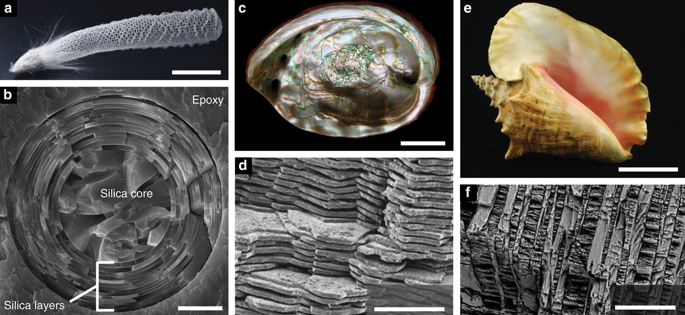当前位置:
X-MOL 学术
›
Nat. Commun.
›
论文详情
Our official English website, www.x-mol.net, welcomes your
feedback! (Note: you will need to create a separate account there.)
Lamellar architectures in stiff biomaterials may not always be templates for enhancing toughness in composites.
Nature Communications ( IF 14.7 ) Pub Date : 2020-01-17 , DOI: 10.1038/s41467-019-14128-8 Michael A Monn 1 , Kaushik Vijaykumar 1 , Sayaka Kochiyama 1 , Haneesh Kesari 1
Nature Communications ( IF 14.7 ) Pub Date : 2020-01-17 , DOI: 10.1038/s41467-019-14128-8 Michael A Monn 1 , Kaushik Vijaykumar 1 , Sayaka Kochiyama 1 , Haneesh Kesari 1
Affiliation

|
The layered architecture of stiff biological materials often endows them with surprisingly high fracture toughness in spite of their brittle ceramic constituents. Understanding the link between organic-inorganic layered architectures and toughness could help to identify new ways to improve the toughness of biomimetic engineering composites. We study the cylindrically layered architecture found in the spicules of the marine sponge Euplectella aspergillum. We cut micrometer-size notches in the spicules and measure their initiation toughness and average crack growth resistance using flexural tests. We find that while the spicule's architecture provides toughness enhancements, these enhancements are relatively small compared to prototypically tough biological materials, like nacre. We investigate these modest toughness enhancements using computational fracture mechanics simulations.
中文翻译:

刚性生物材料中的层状结构可能并不总是增强复合材料韧性的模板。
尽管陶瓷成分很脆,但刚性生物材料的层状结构通常赋予它们惊人的高断裂韧性。了解有机-无机层状结构与韧性之间的联系有助于找到提高仿生工程复合材料韧性的新方法。我们研究了在海洋海绵 Euplectella aspergillum 的针状体中发现的圆柱形层状结构。我们在骨针上切出微米尺寸的凹口,并使用弯曲测试测量它们的引发韧性和平均裂纹扩展阻力。我们发现,虽然骨针的结构提供了韧性增强,但与典型的坚韧生物材料(如珍珠质)相比,这些增强相对较小。我们使用计算断裂力学模拟来研究这些适度的韧性增强。
更新日期:2020-01-17
中文翻译:

刚性生物材料中的层状结构可能并不总是增强复合材料韧性的模板。
尽管陶瓷成分很脆,但刚性生物材料的层状结构通常赋予它们惊人的高断裂韧性。了解有机-无机层状结构与韧性之间的联系有助于找到提高仿生工程复合材料韧性的新方法。我们研究了在海洋海绵 Euplectella aspergillum 的针状体中发现的圆柱形层状结构。我们在骨针上切出微米尺寸的凹口,并使用弯曲测试测量它们的引发韧性和平均裂纹扩展阻力。我们发现,虽然骨针的结构提供了韧性增强,但与典型的坚韧生物材料(如珍珠质)相比,这些增强相对较小。我们使用计算断裂力学模拟来研究这些适度的韧性增强。











































 京公网安备 11010802027423号
京公网安备 11010802027423号